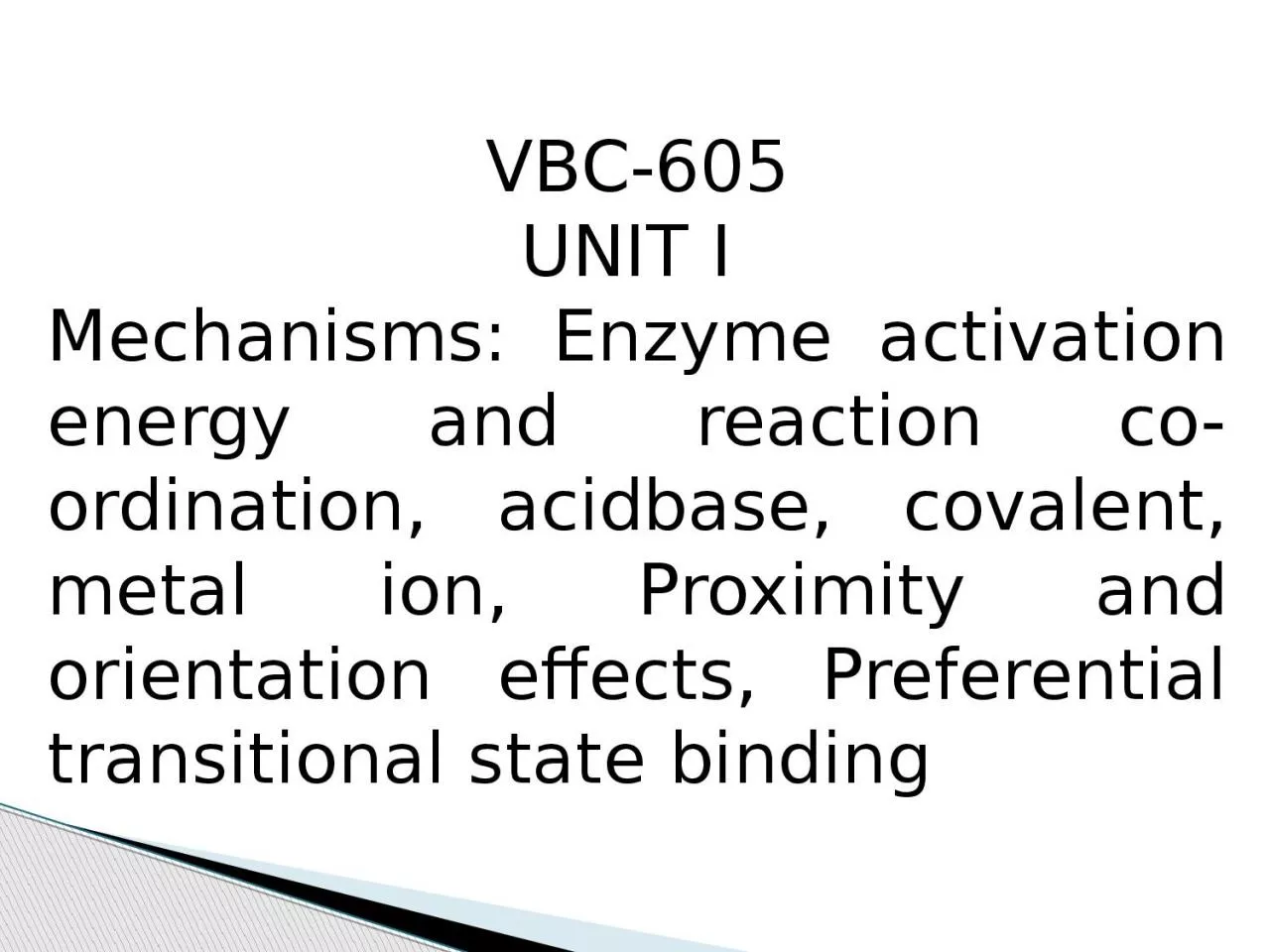

Enzyme activation energy and reaction coordination acidbase covalent metal ion Proximity and orientation effects Preferential transitional state binding Reaction Rates and the ID: 929711
Download Presentation The PPT/PDF document "VBC-605 UNIT I Mechanisms:" is the property of its rightful owner. Permission is granted to download and print the materials on this web site for personal, non-commercial use only, and to display it on your personal computer provided you do not modify the materials and that you retain all copyright notices contained in the materials. By downloading content from our website, you accept the terms of this agreement.
Slide1
VBC-605
UNIT
I
Mechanisms:
Enzyme activation energy and reaction co-ordination,
acidbase
, covalent, metal
ion,
Proximity and orientation
effects,
Preferential transitional state
binding
Slide2Reaction Rates and the
Transition State
Enzymes speed up reactions enormously.
To understand how they do this, examine
the concepts of activation energy &
the transition state.
In order to react, the molecules involved
are distorted, strained or forced to have
an unlikely electronic arrangement.
That is the molecules
must pass through a
high energy state
.
Slide3
This high energy state is called
the transition state.The energy required to achieve it is calledthe activation energy for the reaction.
The higher the freeenergy change for thetransition barrier,the slower thereaction rate.Most stable product is the one with the lowest energy
Energy diagram for a
single-step reaction
Slide4high energy, unstable state in which a molecule is best suited to undergo a chemical reaction; state in which chemical bonds are being broken and formed.
Linus Pauling
postulated that the only thing that a catalyst must do is bind the transition state more tightly than the substrateOld bonds break and new ones formSubstance is neither substrate nor productUnstable short lived species with an equal probability of going forward or backwardStrained intermediateTransition state
Slide5Enzymes
lowe
r energy
barrier by forcing the
reacting moleculesthrough a differenttransition state.This transition stateinvolves interactionswith the enzyme.
Enzyme
Slide6Floating ball analogies for enzyme catalysis
Slide7Energy diagram for
reaction with intermediate
Intermediated occurs in between the two transition statesIn this case, the rate determining step in the forward direction is formation of the second transition state
Slide8Catalytic functions of reactive groups of ionizable amino acids
Slide9Reaction intermediate--- transient chemical species
Rate limiting step
Lowering activation energy is by binding energy
Slide10Modes of Enzymatic
Enhancement of Rates
1) general acid and general basecatalysis-- good proton donors& acceptors positioned
just right.2) covalent catalysis-
unstable intermediate– cysteine, serine, histidine3) metal ion catalysis- electron donor or acceptor
Slide11General base catalysis-
acceleration of a reaction by transfer of a proton
B: = base (proton acceptor) BH+ = conjugate acid (proton donor)A general base (B:) can act as a proton acceptor to remove protons from OH, NH, CH or other XH This produces a stronger nucleophilic reactant (X:-)Acid- Base Catalysis
Slide12Specific Base Catalysis
can remove a proton from water and thereby generate the equivalent of OH- in neutral solution
General Acid Catalysis/ Specific Acid CatalysisProton donors can also catalyze reactionsMany biochemical reactions require acid base catalysisHydrolysis of peptidesReactions with Phosphate groupsTautomerizationsAdditions to carboxyl groups
Slide13involves the formation of a transient covalent bond between the catalyst and the substrate
Group X can be transferred from A-X to B in two steps via the covalent ES complex X-E
Covalent catalysis
Slide14either assist in the
catalyic
reaction, activate the enzyme to begin the catalysis can inhibit reactions in solutionCommon metals that take part in metal ion catalysts are copper and zinc ionThey participate in one of three ways:a. They bind substrates to orient them for catalysisb. Through redox reactions gain or loss of electronsc. electrostatic stabilization or negative charge shielding It can stabilize the unstable transition stateMetal ions are effective catalysts because unlike protons they can be present at higher concentrations at neutral pH and have charges greater than 1.Metal ion catalysis/electrostatic catalysis
Slide15Substrate binding has additional effects that enhance reaction rates
Most
obvious is proximity & orientation Reactants must come together with the proper spatial relationship for a reaction to occur Proximity effects (minor) are most readily observed by comparing equivalent inter- and intramolecular reactions Intramolecular reactions are typically 10-100 fold more rapid Orientation effects are more significant though difficult to quantify Proximity & Orientation Effects
Slide16Enzymes bind the transition state with higher affinity than the substrate or
product
explains why reactions proceed and products are released explains why transition state analogues are excellent competitive inhibitors together with proximity and orientation effects, accounts for bulk of rate enhancement in many enzymes Enzyme mechanically strain substrates towards transition states (rack mechanism) rate enhancement can be expressed in terms of enzyme affinity for transition state compared relative to substrate explains why good and bad substrates typically have similar Km value but different kcat values A good substrate does not need to bind tightly to the enzyme but must bind tightly when activated to the transition statePreferential Transition State Binding
Slide17Induced fit
-
Koshlandenzyme changes itsconformation to accept the transition state of substrate/product well.
Enzyme conformationalchange simultaneous, works to distort and strain substrate forcing it into transition state
Lock & Key Model-
Fischer
Models of Enzymatic reaction
Substrate strain theory
Slide18Expressed in terms of the activity
One International Unit-
the amount of Enzyme that catalyzes the formation of 1 micromole of product in 1 minuteKatal- amount of enzyme catalyzing the conversion of 1 mole of substrate to product in 1 second1 katal = 6 X 107 international unitsEnzyme Units